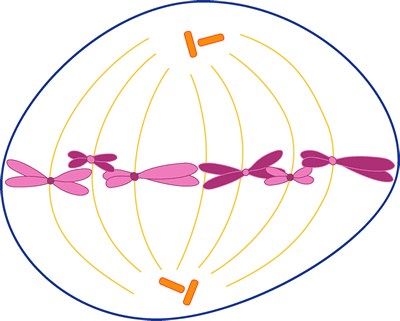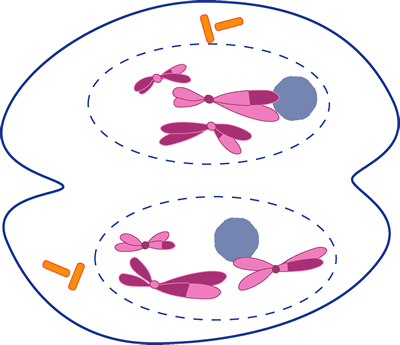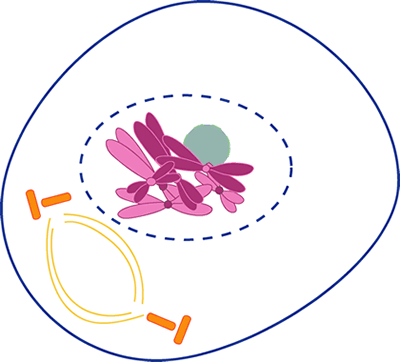Copied and filled out from this document: https://docs.google.com/a/pvlearners.net/viewer?a=v&pid=sites&srcid=cHZsZWFybmVycy5uZXR8OHRoLWdyYWRlLWRsY3xneDo2YWUwNDY1NGNlYWE0YWZh
The questions were asked about this website: http://learn.genetics.utah.edu/content/epigenetics/
IDENTICAL TWINS: PINPOINTING ENVIRONMENTAL IMPACT ON THE
EPIGENOME
1. Often, the physical characteristics of genetically identical twins become increasingly
different as they age, even at the molecular level. Explain why this is so. (use the
terms "environment" and "epigenome")
If the genome is the basis for what shapes a person, then the environment is responsible for changes in a person as s/he ages. Epigenetics, if one was to generalize, is the study of how these changes actually work on a physical or chemical level.
2. Name 3-4 environmental factors that influence the epigenome.
Exposure to specific chemicals (in most research pertaining specifically to epigenetics, these chemicals are artificial, but not always), the release of chemicals within the body as triggered by the environment (the fight or flight response works as an example), and...
3. What is an imprinted gene?
An imprinted gene keeps its epigenetic tags after early development.
YOUR ENVIRONMENT, YOUR EPIGENOME
1. Discuss factors in your daily life (ie. Diet, exercise, stress etc.) that could be affecting
your epigenome.
Arbitrarily applying a very new and experimental science, whose workings are not yet well understood, to one's life would, in all probability, lead to academically useless, completely unscientific and invalid observations. For instance, there is no known link between arthritis and the genome, so is arthritis epigenetic? This website assumes that it is, but that statement is impossible to prove. If I were to break a bone and experience aching in that area for years on, is it epigenetic? I'd like to say no, but that statement also is too broad to prove.
LICK YOUR RATS
1. Explain how a high-nurturing mother rat shapes her pup's epigenome, and what that
pup's response to stress will be.
Methyl groups, which act as the epigenome, silence the GR receptor gene at birth. Nurturing from mothers causes brain impulses in the child to gradually remove these methyl groups, and allows the child to release more GR protein. The GR protein helps to reduce stress, so nurtured offspring will be calmer.
2. In rats, does licking by the mother activate, or deactivate her pup's GR gene?
Nurturing activates the GR gene.
3. Explain how cortisol and the GR protein work together in the brain to relax a rat pup.
You may draw a diagram.
Cortisol is a chemical released during the fight or flight response that can result in stress; the GR protein binds with this chemical to send calming signals, effectively counteracting the cortisol.
4. The rat nurturing example shows us how parental behavior can shape the behavior of
their offspring on a biochemical level. Relate this to humans and think about the personal
and social implications. Record your thoughts.
The repercussions are pretty implicit: that nurture can have an impact in an organism. Although if questionable studies from an experimental science are necessary for parents to care about the wellbeing of their children, then they're probably not capable of being decent parents anyway.
NUTRITION & THE EPIGENOME
1. Explain how the food we eat affects gene expression.
To be laconic: nutrition is responsible for producing methyl groups, which are believed to be responsible for handling epigenetics.
2. Can the diets of parents affect their offspring's epigenome?
Yes, it's very well accepted in the traditional sciences that diet during pregnancy can influence the development of the fetus. Of course, the connection is a bit more complex than that, and it would be a very transparent lie to say we fully understand how it works. For instance, if a child is starved somewhat while still young, his grandchildren will end up living longer lives. It will take time before anyone can pretend to understand the science.
Monday, December 6, 2010
Wednesday, November 3, 2010
Mitosis Worksheet
1. Which stage does the following occur
2.
How many chromosomes are visible at the beginning of mitosis? Eight.
How many are in each daughter cell at the end of mitosis? Eight.
The little green T shaped things on the cell are: centrioles.
What happens to the centrioles during mitosis? The centrioles divide.



| Chromatin condenses into chromosomes. | Prophase |
| Chromosomes align in center of cell. | Metaphase |
| Longest part of the cell cycle. | Interphase |
| Nuclear envelope breaks down. | Prometaphase |
| Cell is cleaved into two new daughter cells. | Cytokinesis |
| Daughter chromosomes arrive at the poles. | Telophase |
2.
How many chromosomes are visible at the beginning of mitosis? Eight.
How many are in each daughter cell at the end of mitosis? Eight.
The little green T shaped things on the cell are: centrioles.
What happens to the centrioles during mitosis? The centrioles divide.
3. Identify the stages of these cells.



Metaphase Telophase Prophase
4. Describe stages of mitosis according to the animation.
Prophase The chromosomes condense. The nucleus dissipates. Centrioles migrate to opposite sides of the cell. | Metaphase Spindle fibers attach to chromosomes. Chromosomes align on the metaphase plate. | Telophase The nuclear envelope reforms. The chromosomes disperse. The spindle fibers dissolve, and the cell is pinched in two by actin protein. |
5. Record data in the chart below.
6. For each organism, identify the stage of mitosis.
Yes, I know the formatting is horrible. I blame blogger.
| Interphase | Prophase | Metaphase | Anaphase | Telophase | Total | |
| Number of cells | 20 | 10 | 3 | 2 | 1 | 36 |
| Percent of cells (calculate: number of cells divided by total cells x 100 ) | 55 | 27 | 8 | 5 | 2 | 100 % |
6. For each organism, identify the stage of mitosis.
View 1 | View 2 | View 3 | View 4 | View 5 | |
| Whitefish | Telophase | Metaphase | Prophase | Anaphase | N/A |
| Onion | Anaphase | Metaphase | Interphase | Interphase | Telophase |
Yes, I know the formatting is horrible. I blame blogger.
Wednesday, October 27, 2010
Guppy Simulation
1. If being flashy and colorful attracts predators, why do you think guppies are so colorful?
Most likely to attract females; no other explanation is really plausible.
2. The fish's common name is guppy or millions fish. Its scientific name is poecilia reticulata. Average size is 3.5 cm.
3. The predator's common name is pike cichlid, its scientific name is crenicichla alta, and originates from Trinidad and Latin America.
4. Predator populations would be heavily influenced by how deep and accessible whatever part of the stream it is.
5. John Endler was an evolutionary biologist who studied wild guppy populations in Trinidad.
6.
Pool 1: Brightly multicolored with large spots.
Pool 2: Medium coloration on body and tail, with medium-sized spots.
Pool 3: Drab coloration, very small spots concentrated near tail.
7. If there are more predators in one area of the stream, then there will be less brightly colored guppies.
8. If the fish are brighter, they're much more likely to be targeted by predators.
9. Yes, in areas with less predators the brightest guppies take over the population. In areas with more predators, only the drabber fish survive. This goes with the hypothesis.
10. Two factors influence the characteristics of a guppy population: the predators, and the mates (natural and sexual selection). Saying that male guppies are caught in the crossfire more or less means this; they need to find a safe median between attracting mates and avoiding predators.
11. Guppies have different coloration in different areas of the stream based on predator population. They adapt to be drabber/brighter when predators are more/less.
12. The guppies would not attract mates because they have so little coloration, but would not be preyed upon. If there are brighter guppies in the area, they would win out over time.
13. The brighter guppies would be preyed upon and would die off due to the high amount of predators, because their coloration would be more visible to predators. Unfortune.
Most likely to attract females; no other explanation is really plausible.
2. The fish's common name is guppy or millions fish. Its scientific name is poecilia reticulata. Average size is 3.5 cm.
3. The predator's common name is pike cichlid, its scientific name is crenicichla alta, and originates from Trinidad and Latin America.
4. Predator populations would be heavily influenced by how deep and accessible whatever part of the stream it is.
5. John Endler was an evolutionary biologist who studied wild guppy populations in Trinidad.
6.
Pool 1: Brightly multicolored with large spots.
Pool 2: Medium coloration on body and tail, with medium-sized spots.
Pool 3: Drab coloration, very small spots concentrated near tail.
7. If there are more predators in one area of the stream, then there will be less brightly colored guppies.
8. If the fish are brighter, they're much more likely to be targeted by predators.
9. Yes, in areas with less predators the brightest guppies take over the population. In areas with more predators, only the drabber fish survive. This goes with the hypothesis.
10. Two factors influence the characteristics of a guppy population: the predators, and the mates (natural and sexual selection). Saying that male guppies are caught in the crossfire more or less means this; they need to find a safe median between attracting mates and avoiding predators.
11. Guppies have different coloration in different areas of the stream based on predator population. They adapt to be drabber/brighter when predators are more/less.
12. The guppies would not attract mates because they have so little coloration, but would not be preyed upon. If there are brighter guppies in the area, they would win out over time.
13. The brighter guppies would be preyed upon and would die off due to the high amount of predators, because their coloration would be more visible to predators. Unfortune.
| % of Brightest Guppies (10 generations) | % of Bright Guppies (10 generations) | % of Drab Guppies (10 generations) | % of DrabbestGuppies (10 generations) | |
| Trial 1 Guppy: Even Mix Predators: 30 Rivulus | 70% | 21% | 6% | 2% |
| Trial 2 Guppy: Even Mix Predators: 30 Rivulus, 30 Acara | 14% | 86% | 0% | 0% |
| Trial 3 Guppy: Even Mix Predators: 30 Rivulus, 30 Acara, 30 Cichlid | 0% | 3% | 2% | 95% |
| Trial 4 Guppy: Mostly Bright Predators: 30 Rivulus | 88% | 9% | 1% | 3% |
| Trial 5 Guppy: Mostly Drab Predators: 30 Rivulus, 30 Acara, 30 Cichlid | 0% | 2% | 6% | 93% |
Wednesday, October 6, 2010
Preservation of Biodiversity
Biodiversity: this is the sort of thing that people can accept on faith as a moral issue (more in the sense that it's the right thing to do than just "oh don't kill the polar bears and baby seals nooooo"). Looking at it as a practical issue, though, ignoring anything morally questionable about it, I'm actually a bit less convinced after researching it than I was before. Don't get me wrong, biodiversity something worth preserving, but we haven't really put together a very compelling argument against saving it from, well, us.
I don't have the prompt handy, but I'm pretty sure this addresses it well enough. This is also pretty excessive for a post, so I guess I should cut it off here. Bye for now.
- One common argument for preserving biodiversity is that there is potentially a great deal of medicines and other, similar benefits from species not yet studied, and if they went extinct we would lose that benefit forever. This begs the question, though, why should we bother preserving biodiversity once we've identified and safeguarded the species' of value to us? Once scientists have meticulously studied and gone through every plant and animal on the planet, this argument no longer holds much validity.
- One less common argument is that biodiversity can act as a safeguard against natural disasters: but usually when this is brought up it only refers to forestation and similar, which seems more like an argument against deforestation than anything, and that is different than biodiversity. For example, why not just select the kind of tree best suited to defending the area and leave the others vulnerable to logging and natural hazards?
- As far as food sources go, with the progress of genetic engineering to create species more useful as food sources, we could preserve the backbone of a diverse diet while allowing other species to phase out at their leisure. Sounds pretty cruel, but again, just an objective view.
- Finally, there's the obvious fact that people appreciate the aesthetics of biodiversity, but that's a pretty superficial cause to spend millions of dollars to preserve, and one that probably wouldn't drum up enough interest to, for example, save the rain forest (heh).
Yeah, I don't know. I haven't seen any other major arguments than these, and it raises questions...
Monday, August 30, 2010
Questions for the Love Canal Committee
- In a word, do you believe Love Canal to be safe or unsafe?
- Do you have any specific, credible studies to back this up?
- How recent is the studies or evidence? (if the person is against living at Love Canal, because most of the people who are against it are citing studies which occurred before the cleaning, meaning the study might no longer apply)
- When you say the area is safe, would you really be willing to live in the area yourself? (if the person is for living at Love Canal, because there seems to be a sort of double standard with some of the people that are for living there)
- Do you sincerely agree with your assigned character's stance? (if the person's character forces the person to have a certain stance on the issue, like Occidental representatives)
Love Canal
The blizzard of 1977 is largely cited as a sort of "fuse" for the chemicals under Love Canal. The snow and precipitation is said to have sunk underground, thereby pushing chemicals to the surface.
Some known effects of the chemicals on humans are cancer, liver problems, oxidative stress and other damage to the nervous system, and even birth defects.
The rest of the ecosystem was affected by the same chemicals: water and the the sediment beneath the Niagara River was contaminated, and chances are that any wildlife in the area would be just as exposed if the chemicals still occupied the Canal.
Some known effects of the chemicals on humans are cancer, liver problems, oxidative stress and other damage to the nervous system, and even birth defects.
The rest of the ecosystem was affected by the same chemicals: water and the the sediment beneath the Niagara River was contaminated, and chances are that any wildlife in the area would be just as exposed if the chemicals still occupied the Canal.
Sunday, August 22, 2010
Hazards of Oil Dispersants
Here's a brief list of the spill's alleged influence on marine life:
- The dispersant used by BP at the beginning of the spill caused internal bleeding
- The dispersant breaks down the lipid membrane of cells, so that oil enters the skin and organs more easily
- As with oil, the dispersant damages the nervous system, immune system, respiratory functions, endocrine, blood, liver and kidneys. The difference is that the both of them together is far worse than either substance on its own.
- Damage to all organs, encouraging or causing cancer, mutations or birth defects
As for whether the oil or dispersant is worse, I'm not really the sort of person to ask. Decisions like that are better left up to toxicologists, and I am of the personal belief that spreading an uneducated opinion, even if it is my own, is a very stupid thing to do. If I know only part of the situation, based on pieces of only one or two viewpoints, then I'm hardly justified to make observations based on it (regardless of how common this is). What's more, there's no such thing as a scientific opinion. This might be a rather long way to write out "I don't know enough on the subject to have a respectable opinion" but I hope this is enough that you can understand where I'm coming from.
We as a whole know only part of the situation, actually. Most information on the dispersant is locked up as "trade secrets," and as the video states, the release of information on the dispersant as requested by the government really didn't happen: the most relevant information was largely skipped over or ignored in any public reports.
An addendum for anyone who feels like hating on BP today: British Petroleum donated one BILLION dollars to be used for an alternative to oil dispersants for any future spill by any company in the oil industry, regardless of how poorly they may have handled their own problems. With all of the ridiculous spending going around it may be hard to put in perspective, but let me say it simply: that is a lot of money.
An addendum for anyone who feels like hating on BP today: British Petroleum donated one BILLION dollars to be used for an alternative to oil dispersants for any future spill by any company in the oil industry, regardless of how poorly they may have handled their own problems. With all of the ridiculous spending going around it may be hard to put in perspective, but let me say it simply: that is a lot of money.
Wow, this is a lot of text. @_@ I hope you don't expect this for every blog post!
Subscribe to:
Posts (Atom)